Teacher’s “Pet”
December 20th, 2013 in Anime, General Reviews by The Droid
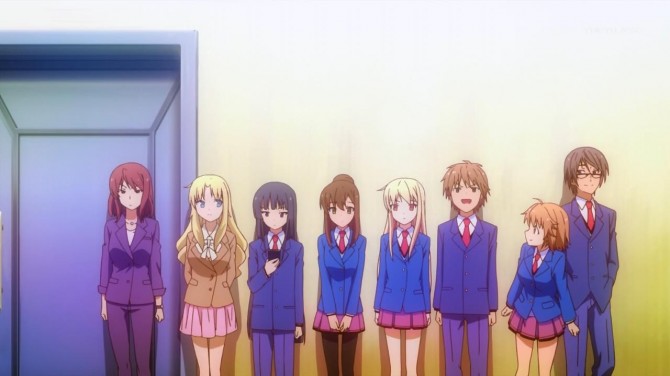
This is one of the odder school romance anime shows I have seen, mainly because the main thrust of it doesn’t make any real sense, but, being a comedy, I guess it’s not supposed to make sense, as we have to make the story work, more or less.
“The Pet Girl of Sakurasou” (“Sakura-sō no Petto na Kanojo”) tells the story, initially, of Sorata Kanda (that stiff guy three in from the right). He attends Suimei University of the Arts (often shortened as Suiko), but he is a ‘problem’ child. He is a problem as he took in an abandoned cat, in the hopes of finding a new owner for it. Well, that didn’t happen, and pets aren’t allowed in the dorms, so he was ‘transferred’ out (read that as ‘hit the bricks, bozo’), as he wouldn’t surrender the cat, and into the Sakura Dorm. In this world, it’s like a one-way bus ticket to Cleveland: you go in, you never come back out to the normal world. I hope you enjoy seeing Lake Erie catch on fire. (Well, actually it was the Cuyahoga River, in June of 1969).
Now, these people in the dorm (and it doesn’t house that many; only about six. In a school this size, there are only six problem students? Really?) are all very creative and highly intelligent, just a tad on the addled side. Thrown into this mix is Mashiro Shiina (to Sorata’s right). She is so addled that she cannot even dress herself in the morning and needs a handler to help her. OK, who gets the job of being her handler? Who haven’t I called on in a while? That right! Sorata gets this dubious job. Feed her, dress her, get her to class, bring her home, help her pass her tests, etc., etc., etc. (more…)
Tags: Comedy, Drama, Romance, School
Short Run Series XIII – There is No “Spoon”
December 14th, 2013 in Anime, General Reviews, Short Run Series by The Droid
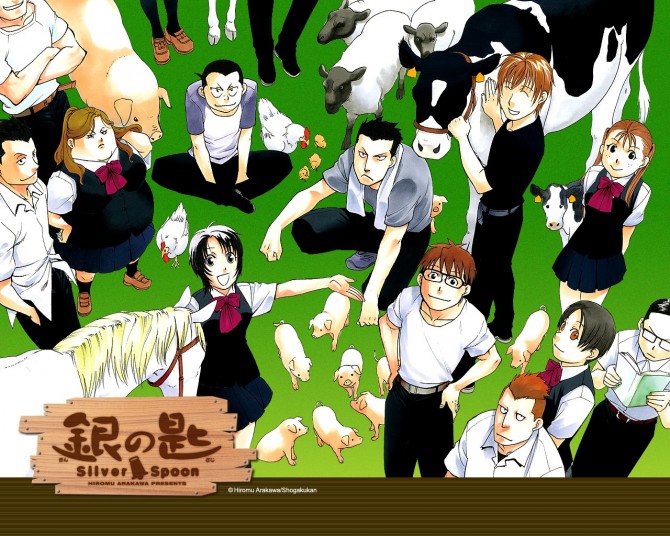
Although ostensibly a school romantic comedy, it is the setting that makes it a bit different from your regular school animes.
“Silver Spoon” tells the story of Yugo Hachiken (the guy in glasses). He comes from Sapporo, but had no real idea what he wants to become. He also wanted to get away from a demanding father and a slacker brother, so he enrolls in Ezo Agricultural High School. He is the only one there without a goal, a purpose or a reason to be at this school, as everyone else is involved in some aspect of agriculture (dairy, livestock, horse racing, cheese making and the like).
He becomes tops in the class overall, as he excels in the regular stuff (math, history, writing), but he bites mightily when it comes to the other aspects of the school, like the agricultural part. I hope he didn’t miss that ‘agricultural’ is part of the school’s name. His other classmates are: (more…)
Tags: Comedy, School, Shounen, Slice of Life
“New” and Improved
December 13th, 2013 in Anime, General Reviews by The Droid

“High School DxD – New” is the second season of this show. There were so many loose ends left at the end of the first season, the only real question was “When is season two coming out?” Now it has, and we continue on with both training and fighting.
Let us recap the cast, for those who may have forgotten:
Issea Hyodo is a demon, smack dab in the middle.
To his right is the president of the Occult Research Club, Rias Gremory
The three lovelies above are Akeno Himejima, Koneko Toujou and Asia Argento.
(There is another guy, Yuto Kiba, that’s him to the far right, with his marvelous new sword).
Now, with the battle between demons, fallen angels and angels still raging, the Church decides to send out its own minions, those two spandex-clad femme fatales, Irina Shido and Xenovia. (more…)
Tags: Action, Comedy, Demons, Ecchi, Harem, Romance, School, Shounen
“Stella”!
December 12th, 2013 in Anime, General Reviews by The Droid

This is another entry into the “Women and Weaponry” genre. We started with “Upotte!” went to “Girls und Panzer” and now we have “Stella Women’s Academy, High School Division Class C3“, which we’ll call “C3-Bu”.
Yura Yamato (front and center) has just transferred to the prestigious Stella Women’s Academy, but is having a hard time fitting in, as her timid nature and robust fantasies of what could happen seem to take over her waking life, so she is all by herself. She is asked to join the airsoft club, but is scared off by the more forceful members of the club, which include (left to right, as always):
Honoka Mutsu, tactics and logistics
Yachiyo Hinata, sniper
Karila Hatsuse, close-quarters combat
Rento Kirishima, support and back-up
Sonora Kashima, club president and Yura’s roommate. (more…)
Tags: Military, School, Sports
“Fault” Line
December 11th, 2013 in Anime, General Reviews by The Droid

Another show with a monstrapatious title, this is “Watashi ga Motenai no wa dō Kangaetemo Omaera ga Warui!”, also known as “WataMote” and for those of you not fluent in Japanese, we’ll call it “No Matter How I Look at It, It’s You Guys’ Fault I’m Not Popular!”
It revolves around Tomoko Kuroki, as she is going to be a first-year in high school. Having conquered dating Sims games, she believes, to the very fiber of her being, that she will be fiercely popular. She painfully discovers this is far from the truth as she winds up being an unsociable loner and is forced to take a long hard look at herself for the first time in years.
I had a very difficult time with this show, as I was never really certain if it was a comedy (as she makes all these horrible mistakes and missteps in trying to break out of the jail she has put herself in) or a tragedy (as we kind of see a slide into insanity, as she is unable to cope or understand what is going wrong with her life). All of her attempts meet with failure and there is honestly no one she can turn to for guidance, help, a shoulder to cry on, or perhaps something from the local WacDonald’s to nosh upon. (more…)
Tags: Comedy, School, Shounen, Slice of Life
“Photo” Op
November 28th, 2013 in Anime, General Reviews by The Droid
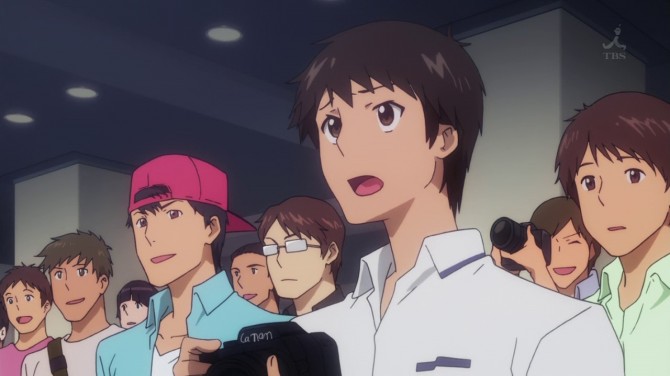
This actually is a two-part series, in that what happens in the first half has almost no bearing on the second half.
Now, it doesn’t help that it started out as a dating sim game. “Photo Kano” (“Photo Girlfriend”) tells the story of Kazuya Maeda (Mr. Front and Center), who was given a digital camera from his father. All of a sudden, there is an uptick in his popularity and presence (neither of which he had before), as he learns to not only take good photos, but gets involved with a series of girls, each needing something else from him, both romantically and photographically.
From shows One to Six, we see Maeda run through his paces. There are two photo clubs on campus, but the first one, The Photography Club (the one he joins) is more interested in taking those flirty, ecchi-like snaps of the student’s body…..I mean, the student body. The second one, the Photo Club, is more serious about what they do, so the two clubs are always in conflict with approach and goals and results. (more…)
Tags: Ecchi, Romance, School
A “Prince” of a Guy
November 4th, 2013 in Anime by The Droid
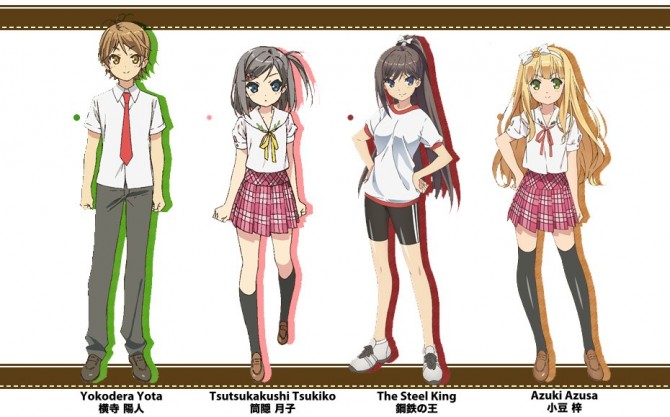
OK, I was drawn to this series by the title: “The ‘Hentai’ Prince and the Stony Cat”. Well, I jumped on “Panty and Stocking” and “Chu-Bra!” and I found those very entertaining shows, so why not this one?
This revolves around Yokodera Yota, a second-year high school student. He has a reputation on campus as being the biggest pervert around, but he has a problem: he cannot express his emotions well. One day, a good friend of him comes up to him and unloads all of his smut collection on him, as he has been cleaned of his impure thoughts. All he did was make an offering to the stone cat statue at the base of a tree on the high peak in town. What it does it takes what you no longer want and gives it to someone in greater need of it.
As he goes up there to make his offering of a body pillow, wishing to be more open with his emotions, a girl comes up to him, Tsukiko Tsutsukakushi, and makes her wish of being more of an adult and not show her emotions so easily. The cat grants their wish and the next day at school is a total disaster. He cannot tell a lie; she cannot feel anything. They work together to try and find who received their tokens and try to get it back so they can be who they once were, as who they are now is nerve-wracking. (more…)
Tags: Comedy, Romance, School, Seinen, Supernatural
Get a “Job”
October 29th, 2013 in Anime, General Reviews by The Droid
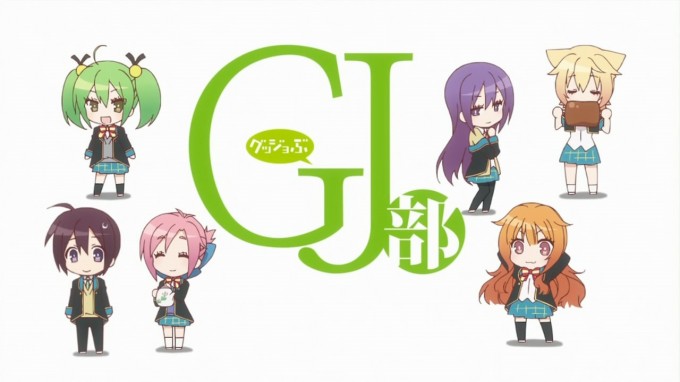
I have noticed, as of late, a trend in anime shows to have what I call the “Join a Club” movement. These are shows where the person in question is forced or compelled or enticed or blackmailed into joining a club or they will have to face some kind of dire wrath for their failure not to sign up (as you might end up in the Flower Arranging Club instead).
The “Good Job Club” tells the tale of Kyōya Shinomiya (that guy down there), who gets kidnapped by the club, as they are on the verge of losing their accreditation, owing to the problem that they do not have enough members. He makes it five and they can be saved. The sole purpose of the club is to do good deeds (or a ‘good job’) and help others, but it all seems to be observed more in the breach than in reality.
The other members of the club include:
Tamaki Kannazuki, green hair. She usually has a bag of chips with her and says she can eat anything and not get fat.
Megumi Amatsuka, with the tea pot. She is constantly making tea for everyone, but flips out if someone says she is gaining weight. (more…)
Tags: Comedy, School, Slice of Life
Something Out of the “Ordinary”
October 20th, 2013 in Anime, General Reviews by The Droid

This starts out as an entry in the ‘nothing’ show category, as it is nothing more than a series of disconnected stories and tales that sometimes have no point, regaling in the strangeness that life has to offer.
When it was a manga, it was called “Regular Life”, but when it became an anime, it turned into “My Ordinary Life”, and is highly reminiscent of “Daily Life of High School Boys”, in that we see these events and you can watch the show out of order or miss an episode and you do not miss (that) much.
The tales are broken into two portions: school life and laboratory life. The school life segments involve Mai Minikami (Slot 1) who is very intelligent, but very quiet, Yuko Aioi (Slot 2) who is always forgetting to do her homework or forgetting to bring her homework if, by some rare confluence of time and space, she has managed to actually do it and Mio Naganohara (Slot 4) who is a manga artist, but doesn’t want people to know this. We see them go through the paces of being in school. The three of them have a caliber of relationship as was seen in “Kill Me, Baby” (minus the physical mayhem) but it is played for strangeness, as when Yuko is sent into the hall for not doing her homework and sees the vice-principal have a wrestling match with a deer that has come on campus. (more…)
Tags: Comedy, School, Slice of Life
You Don’t Bring Me “Flowers”
October 3rd, 2013 in Anime, General Reviews by The Droid
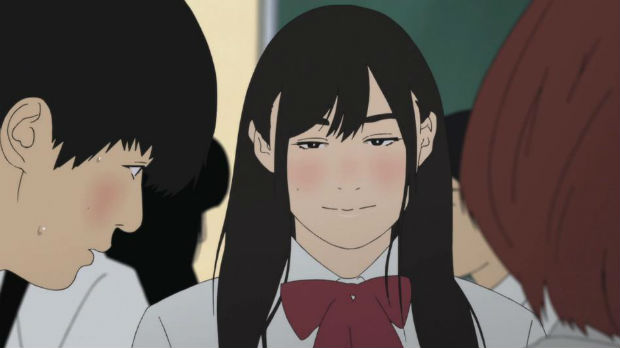
This is a very black or white series. You will either love it or hate it, but you will never be uncertain about it.
“Flowers of Evil” (or, as they call it, “Aku No Hana”) is doing things I rarely see in animation and I have never seen in anime. First, it is rotoscoped. For those who do not know what that is, you film live action, then animate it. “Through a Glass Darkly” was the last time you may have seen it (or not; it was a stinky film). What this means is that you have a more natural look, but the movements may come off as stiff or stilted, as you are not employing squash-and-stretch techniques of normal animation.
Second, because of the more natural look, standard anime tropes are gone. With the exception of one fantasy sequence, there is no turning to stone and crumbling away or sliding into chibi style or anger bars flashing at one’s forehead when things go wrong.
Third, the more natural look means the world is dirty and grimy and depressing, so there are chipped concrete blocks and cracked roads and torn posters and rusting signs and stained walls and weed growth. Certainly not crisp and clean, no caffeine, as you see in even the most action-adventure animes. (more…)
Tags: Drama, Psychological, Romance, School









